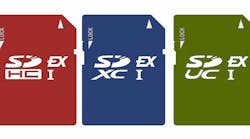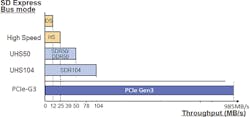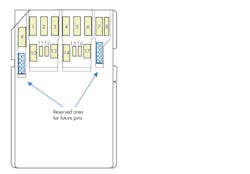Removable storage is hot at this year’s Flash Memory Summit.
The SD card has been the mainstay for compact removable storage in embedded systems as well as commercial and consumer products like digital cameras and smartphones. It simply provides a way to deliver removable NAND flash-memory storage. SD and microSD cards using quad-level-cell (QLC) NAND flash provide immense amounts of storage in a compact form factor.
1. Switching to PCI Express and NVMe provides a significant performance boost.
The challenge for these form factors is the bandwidth of the interface. The SPI interface made it possible for most microcontrollers to access these storage devices. The SD interface improved on the SPI support and typically SD cards are accessed using the 1-bit or 4-bit SD interface. Though the interface speeds scaled well, they were much slower than PCI Express, which is now the favored interface for high-performance storage using protocols like NVMe (Fig. 1). The UHS-I SD interface runs at 104 Mbytes/s.
Enter SD Express (Fig. 2) from the SD Association. The original MMC card brought us the SPI version while the SD Association delivered the SD interface. SD Express retains the form factors but changes the interface to include PCI Express, boosting potential throughput to a whopping 985 MB/s. This higher transfer rate is needed to accommodate applications like 360-degree cameras as well as high-capacity storage devices. Otherwise, they would take an extraordinarily long time to transfer all of their data.
SD Express is part of the new SD 7.0 standard. This includes SDXC with up to 2 TB of memory and an SD Ultra Capacity (SDUC) that supports up to 128 TB.
The move to PCI Express changes the landscape for storage, since it requires a host that supports PCI Express. It’s standard on high-end microprocessors, but will not be available on microcontrollers where SPI or QSPI will be the norm. Therefore, existing cards will likely remain a viable option for some time to come.
2. The form factor remains the same with the same pins for SD Express with PCI Express functionality.
It’s also possible to implement a card so that it provides both PCIe and SD interfaces, albeit slower for the SD interface. This provides interchange between devices with different interface support. However, it will lead to long transfer times for large amounts of data on SD interface-based platforms.
On the plus side, it puts the SD cards on the same level as internal NMVe storage that’s more common on motherboards and the de facto standard on PCIe slot-based and M.2-based servers. NVMe provides support for features like bus mastering, multi-queue, and host buffer memory that was lacking in the older, SD interface cards. Of course, it increases the complexity of the controllers, but that’s built into PCIe-based solutions.
The new standard will have a major impact on embedded systems where large amounts of fast, removable storage can now be utilized. High-performance systems often incorporated SD cards for data interchange, but used other storage options for high-speed operation. Having a storage system that merges well with these high-speed options will simplify system and software implementations.




